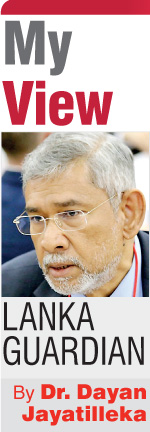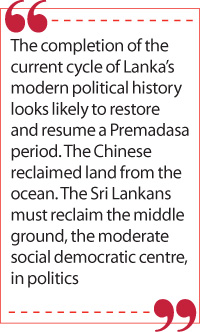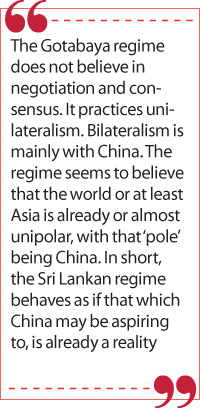Sunday Apr 20, 2025
Sunday Apr 20, 2025
Friday, 28 May 2021 00:05 - - {{hitsCtrl.values.hits}}

The 2020s are to the Rajapaksas what the 1970s were to the Bandaranaikes: the transitional time of exaltation and exit. The Rajapaksa arc of contemporary political history has begun to bend. Hardship, injustice and chaos will be the hallmarks and abiding public memories of this Government. The electorate will want neither repetition nor return. Recovery may take over a decade
 During the historic Parliamentary debate on the Port City bill, the Leader of the Opposition charged that it had been drafted by a lady who worked for a private sector firm (I vaguely recall him saying it was a foreign private sector firm). I expected the Minister of Justice to rebut him while he was on his feet, and state that it was the Legal Draftsman who had done so. But the charge went uncontradicted and must therefore be assumed to be true.
During the historic Parliamentary debate on the Port City bill, the Leader of the Opposition charged that it had been drafted by a lady who worked for a private sector firm (I vaguely recall him saying it was a foreign private sector firm). I expected the Minister of Justice to rebut him while he was on his feet, and state that it was the Legal Draftsman who had done so. But the charge went uncontradicted and must therefore be assumed to be true.
The Opposition represented by the diligent Dr. Harsha de Silva moved a number of amendments. The very act signals constructive engagement. Had the Government accepted a few, or even one or two, it would have given the Port City bill a legitimising veneer of a bipartisan buy-in and the cover of minimal consensus. The Government rejected and overrode all the proposed amendments.
What these strange anomalies showed was that the Port City bill was customised, but by whom, for whom, and for what?
One country, two systems
The Port City legislation was the second of two major makeovers of Sri Lanka’s State framework. The first was the 20th Amendment.
The 20th Amendment made the State structure hyper-centralised and top-heavy. The Port City law makes its geo-economic and geostrategic profile lopsided. That combination of structural top-heaviness and lopsidedness can capsize the system.
The 19th Amendment, having proved itself flawed, could have been revised or replaced by a cross-party consensus, just as the amendment had been promulgated by one. Alternatively, the amendments proposed by the Prime Ministerial Committee could have been incorporated. They weren’t.
The USA, India, EU, Japan and others who may perceive problems with the Port City could have been engaged in dialogue by the Government and their suggestions taken on board before presenting the Bill. That would have neutralised possible countermoves by powerful global and regional players and even brought them on board. It didn’t happen. 
The Gotabaya regime does not believe in negotiation and consensus. It practices unilateralism. Bilateralism is mainly with China. The regime seems to believe that the world or at least Asia is already or almost unipolar, with that ‘pole’ being China. In short, the Sri Lankan regime behaves as if that which China may be aspiring to, is already a reality.
‘One Country, Two Systems’ was the doctrinal formula that summed up the special relationship between Hong Kong and mainland China to which it historically belonged before separation by colonial control. The formula was also meant to attract Taiwan back to the fold. The anarchic rioting of 2019 jeopardised that formula, and the understandable, inevitable, yet counter-productively excessive Chinese pushback has almost finished it off. Now it’s ‘One Country, One-and-a-Half Systems’ at best. Has ‘One Country, Two Systems’ been reborn in Sri Lanka which now has a small artificial island as add-on?
The TNA’s Sumanthiran and Rasamanikkam refer to the levy imposed on goods purchased in but taken out of the Port City by non-residents. They correctly identify this as a customs duty imposed at border crossings.
My question is this: if Jaffna Mayor Manivannan was arrested for the crime of appointing a municipal security unit which wore a uniform which resembled not only that of the LTTE-appointed police force but also of the current Colombo Municipal Council, what would be Colombo’s response were the Northern and/or Eastern Provincial Council to charge a levy on goods—say, mangoes, onions and prawns—purchased within the province by non-residents on their way back to the south? The Council would be dissolved for a ‘separatist’ gesture, the Chief Minister and Cabinet arrested and any civic protest crushed by the military.
 Hard right pivot
Hard right pivot
The writing was on the wall (and in the media) three years back, in May 2018, following Gotabaya Rajapaksa’s impressive Viyath Maga convention:
“…Two things worry me. One is that strident Tamil political adventurism has generated an Alt-Right mood and momentum among all classes in the South, rendering society ripe for a Netanyahu-Trump type ‘turn’/‘pushback’...There is an affluent bilingual Sinhala elite (not merely the lower middle classes) including in the Diaspora, which has converted to a New Right neoconservative nationalism.
My second concern is the economic policy model that was rolled-out at the Shangri-La by Gotabaya. As a high-growth strategy on the right flank of the Mahinda coalition, under Mahinda’s leadership i.e., a sub-set of a larger Mahinda policy paradigm, it would be fine. However, as a stand-alone model or the dominant (Presidential) one, it will generate major structural contradictions, triggering a cycle of conflict.
The GR model as unveiled at Viyath Maga gave no importance to poverty, the peasantry, landlessness, inequity, poverty reduction, and social upliftment. It had no place for the people or social justice. The goal was high economic growth with law and order. Social questions and public welfare were conspicuously absent and the assumption seemed to be ‘trickle down’. The vision is socially ‘thin’, ungrounded; a holographic projection with little social ‘thickness’, inclusivity, depth or rootedness in complex social reality.
This paradigm is a throwback to the ‘ASEAN model’ of the UNP of the 1980s—particularly the ideology of Lalith Athulathmudali in the ’80s. Athulathmudali was close to Reaganite Republicans, a friend of hawkish US Defence Secretary Caspar Weinberger, had taught in Israel and Singapore, held tough rightwing views on economics, student protest, the ethnic issue and foreign policy and pushed the ‘Israeli (Occupied Territories) model’ for the Tamil Question.
The UNP’s economic doctrine produced an early-1980s ‘high growth bubble’. The governing elite ignored the warnings of Prime Minister Premadasa about poverty and inequity. He tabled the Warnasena Rasaputram Report on Poverty, building on a UNICEF study. The prevailing economic and (authoritarian) political model caused a volcanic insurrection by underprivileged youth.
A top-down technocratic model did not work in Sri Lanka in the 1950s—when it triggered the August 1953 ‘Hartal’—or in the 1980s despite the heavy ‘law and order’ fist of the Jayewardene-Athulathmudali regime.
Translated into SLFP history, Gotabaya’s vision is like that of Felix Dias Bandaranaike in the 1970s, representing the SLFP Right rather than the Rajapaksian centre-left, progressive Populism. The paradigm generates contradictions and resistance along three axial routes:
The South-South axis, where social insensitivity, inequity and structural marginalisation will trigger clashes with students, workers, peasants, fisherfolk and neighbourhood communities.
The North-South axis, where tokenistic integrationism/assimilationism in place of a geopolitically sustainable political equation, will render the Tamil Question utterly intractable.
The Democracy-Autocracy axis, where the top-down technocratic model itself requires authoritarianism (Felix called it “a little bit of totalitarianism”) and will thereby erode legitimacy and trigger resistance.
Gotabaya surely can and must do better. The people are the nation. Any truly national project must be a people’s project. So far, this is not a people’s project. It lacks a social soul…”
(‘Gotabaya’s Breakthrough’, Dayan Jayatilleka, At Variance, Daily Mirror, 23 May 2018.)
China and the clan
It is difficult to believe that the Port City law has made the Government more rather than less popular. It is also difficult to believe that the Government’s legitimacy has been enhanced by the new law, and will be enhanced rather than diminished as the project gets going. An old witticism among political scientists is that nothing is quite so pathetic as an unpopular populist. The same goes for a regime predicated on sovereignty and nationalism, which finds itself casting a shadow in which a much larger shadow of a foreign power looms over it.
In China’s great revolution the Chinese Communist Party underscored the distinction between the ‘national’ and the ‘comprador’ bourgeoisie. The former was deemed to have a progressive role to play in developing the productive forces especially in national industry. The national capitalist class was progressive because it had a contradiction with encroaching foreign interests and stood with the people against such encroachment.
The ‘comprador’ capitalists were mainly non-industrial and therefore made no direct contribution to the growth of the national economy. They were intermediaries between the foreign and the local, inextricably intertwined as junior partners with big foreign capitalists and foreign powers. The comprador capitalists were incapable of standing for national independence, sovereignty and the national interest and were the local agency of the subordination of the nation to external hegemony.
The Gotabaya Rajapaksa regime no longer represents the national bourgeois. It has granted more foreign and less national control than even the Yahapalanaya Government conceded in its agreement with China on the Port City—which Dr. Rajitha Senaratne emphasised in the Parliamentary debate, without contradiction by the Government. The ruling GR bloc now primarily represents the comprador bourgeoisie. Its patriotism and nationalism have degraded to its hardcore ethnoreligious majoritarianism.
The medical and agriscience communities are critical of and alienated from the Gotabaya administration. The ruling bloc is also losing its organic character by degenerating into the agency of a rising foreign power while simultaneously presiding over the ruination of rural agriculture and the peasantry, risking skyrocketing food prices and urban hunger. The age-old Social Contract between the State and the peasantry has been unilaterally broken by the Gotabaya Government, ironically just as it takes a great leap forward in implementing its contract with China over the Port City.
Comparative international politics proves that when a clan finds an external patron, it seeks to turn that patron into a prop for continued incumbency, without recourse to free and fair elections. When the client-clan gives the external patron a chunk of strategic or lucrative real estate, it is usually as a means of securing the backing for a long stay, and the patron is usually tempted into providing such backing.
Eventually, the narrow base of an autocratic clan-based power structure generates contradictions with the rest of the social totality, while the external prop delegitimises the ruling clan nationally. The excluded social classes, driven by the working people while often led by the middle classes, then combine to cut down the family tree; the oligarchy.
If an electoral exit ramp is available, the landing is a soft one, but if not, there is upheaval and crash-landing. In an island that experienced three powerful armed revolts in 50 years, that is hardly unthinkable, but if a revolt recurs it will either be an unarmed popular uprising or would have the organic social base that the previous (generational) rebellions lacked.
Former President Mahinda Rajapaksa’s place in history is and will remain irreducibly indelible as the leader who led the nation to victory over a powerful separatist-terrorist enemy whom none before him wished to, could or did vanquish. However, the Port City law’s profile will cast the Rajapaksa clan as a collective client and proxy of a foreign power and presence. That will inevitably cast a shadow upon, and could even shrink by some degree, the historical stature of Mahinda Rajapaksa himself.
Though the Rajapaksas surpassed Jayewardene, Premadasa and the last Bandaranaike in office by winning a war against a historic foe, the Gotabaya Government’s ‘voodoo economics’ will cause agrarian ruin and urban food shortages (for which neither COVID nor China are to blame) while the untimely, excessive, unwise lock-in with China will diminish patriotic legitimacy and provoke irresistibly powerful external blowback. The combination will create a crisis which makes the Bandaranaikes and all post-1948 heads of state and government look comparatively wiser than the Rajapaksas.
The 2020s are to the Rajapaksas what the 1970s were to the Bandaranaikes: the transitional time of exaltation and exit. The Rajapaksa arc of contemporary political history has begun to bend. Hardship, injustice and chaos will be the hallmarks and abiding public memories of this Government. The electorate will want neither repetition nor return. Recovery may take over a decade.
 Fly like an EAGLE
Fly like an EAGLE
The regime’s last card will be a new Constitution that strives to divert attention from lost sovereignty by declaring Sri Lanka a Sinhala-Buddhist state, buttressed by a new electoral system that marginalises minorities and enhances majoritarian hegemony.
A similar shift—discriminatory standardisation of marks, the 1972 Constitution—didn’t work for the Bandaranaikes in the 1970s. Today it will run against the global mood on racial justice and equal rights that shifted opinion among US Democrats and forced Netanyahu to a Gaza ceasefire after 11 days. It may legitimise the case for Tamil self-rule even through external agency.
This leaves a fusion of Netanyahu’s polarising strategy of endless conflicts and Myanmar’s military rule as the only option for GR-led, Beijing-backed Rajapaksa rule.
That worst-case domestic scenario runs up against powerful global dynamics. The bipartisan Resolution H.413 on Sri Lanka in the US Congress Foreign Relations Committee calling for international accountability, must be read together with the vastly more important 470-page EAGLE (‘Ensuring American Global Leadership and Engagement’) Act, piloted by Gregory Meeks, US Democrat and Chairperson of the House Foreign Relations Committee. The EAGLE Act and similar legislation in the more powerful US Senate, will provide the policy framework for the USA towards China. A defining line reads:
“The United States must coordinate closely with allies and partners to compete effectively with (China), including to encourage allies and partners to assume, as appropriate, greater roles in balancing and checking aggressive (Chinese) behaviour.”
The EAGLE Act may mandate the US Government to ‘coordinate closely with allies and partners’ and ‘encourage’ them to ‘assume…greater roles in balancing and checking’ the expanded space and influence recklessly ceded by the Sinophile power-cartel ruling our strategic island.
Reformist agenda
The New Opposition must combine a tough centrism with a soft leftism. It must construct and represent an organic ‘national-popular’ bloc (to use Gramsci’s term) of national capitalists, peasantry, youth, workers, middle classes, women, minorities and marginalised. It should represent national independence, sovereignty and the national interest, grounded in the social interests of the 99%, while the 1% is gated in its citadel, the Port City, a Versailles which may turn Bastille.
Lanka requires a realistic reformist agenda:
(1) The top-heaviness of the executive presidency can be rectified only by stepping away from the 20th Amendment while not sliding all the way back to the 19th.
(2) The absence of autonomy for the Tamils can be rectified only by the reactivation of the 13th Amendment within the parameters of the unitary state.
(3) The lopsidedness in Sri Lanka’s external affiliation can be corrected only by re-setting the Port City as a level playing field through a ‘Concert of Powers’ rather than the patronage of one.
(4) The problem of accountability can be realistically addressed only by an internationally credible, independent national mechanism and process.
(5) The economy can sustainably take-off and the burdens of the citizenry be lifted, through inclusive growth with equity in a social democratic Open Economy, not neoliberal free-market fundamentalism or a closed economy.
The completion of the current cycle of Lanka’s modern political history looks likely to restore and resume a Premadasa period. The Chinese reclaimed land from the ocean. The Sri Lankans must reclaim the middle ground, the moderate social democratic centre, in politics.